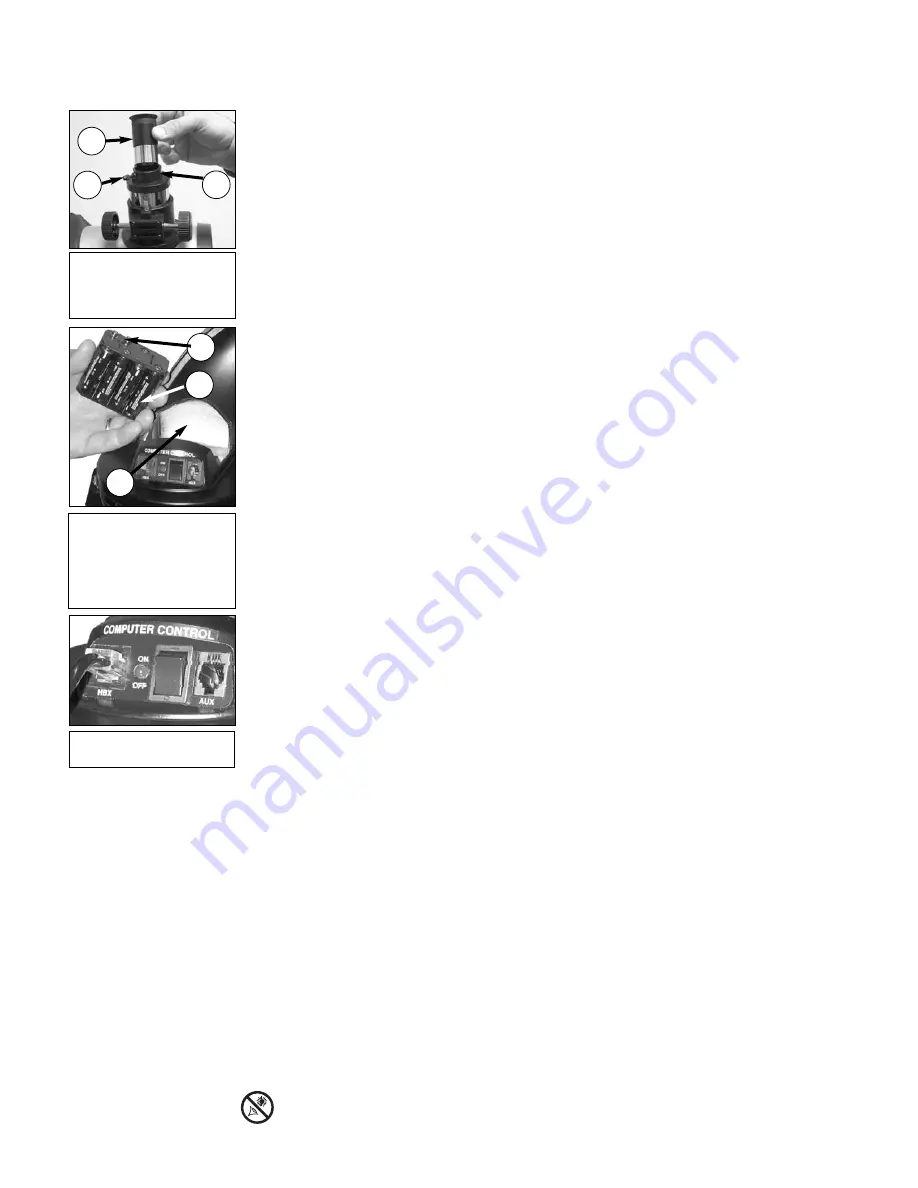
12
Looking at or near the
Sun
will cause
irreversable
damage to your eye. Do not point this telescope at or near the
Sun. Do not look through the telescope as it is moving.
Remove the battery holder from the compartment and carefully lift the 9v connector out
from the compartment. Take care not to accidentally detach the wires of the battery con-
nector from the base. Whenever you replace the batteries, to safeguard the wires, discon-
nect the 9v connector from the battery holder before removing the batteries.
Insert eight AA-size batteries into the battery holder, oriented as shown on the diagram on
the battery slots of the battery holder. Connect the 9v connector plug to the battery holder.
Carefully replace the battery holder back into the battery compartment. Replace the cover.
CAUTION:
Use care to install batteries as indicated by the battery compartment.
Follow battery manufacturer's precautions. Do not install batteries backwards or
mix new and used batteries. Do not mix battery types. If these precautions are not
followed, batteries may explode, catch fire, or leak. Improperly installed batteries
void your Meade warranty. Always remove the batteries if they are not to be used
for a long period of time.
14.
Connect Autostar:
Be certain that the power switch on the computer control panel is in
the OFF position. Plug the coil cord of the Autostar Controller into the HBX port
. Turn on
the power switch; the red LED lights when power is supplied to the panel. See
Fig. 12.
NOTE:
The Autostar handbox does not require batteries; the telescope’s batteries
supply power to Autostar.
15.
Remove the dust cover:
Pull out the dust cove
r
(
12, Fig. 1
) from the optical tube assem-
bly (
13, Fig. 1
).
Assembly of the basic telescope is now complete.
The Red Dot Viewfinder
Because the main telescope has a fairly narrow field of view, locating objects directly in the
main telescope can sometimes be difficult. The red dot viewfinder (
Fig. 13)
projects a small red
dot that permits you to more easily locate objects. When the red dot viewfinder and optical tube
are aligned to each other, both point to the same position in the sky. An object located in the
viewfinder is therefore in the eyepiece of the main telescope.
Aligning the Red Dot Viewfinder:
It is recommended that you perform steps 1 through 4 of this procedure during the daytime and
step 5 at night.
1.
Loosen the tripod base lock knob (
26, Fig. 1
) and the Altitude lock (
10, Fig. 1
), so that the
telescope can move freely.
2.
If you have not already done so, place a low-power (
e.g., 25mm) eyepiece in the diagonal
prism of the main telescope (
3, Fig. 1)
and point the telescope at an easy-to-find land
object (
e.g., the top of a telephone pole or sign). Turn the focuser knob (
1, Fig. 1
) to focus
the image in the eyepiece. Center the object precisely.
3.
Re-tighten the tripod base lock knob (
26, Fig. 1
) and the Altitude lock (
10, Fig. 1
) so that the
telescope does not move during the procedure.
4.
Rotate the intensity knob to turn the red dot viewfinder On (rotate the knob to change the
intensity of the red dot; see
Fig. 13
). Looking through the viewfinder. Turn the viewfinder’s
two alignment screws (
8, Fig. 1
) until the viewfinder’s red dot points precisely at the same
object as centered in the eyepiece. The red dot viewfinder is now aligned to the main
telescope.
5. Check this alignment on a celestial object, such as the Moon or a bright star, and make
any necessary refinements.
Fig. 11: Insert eight AA-size
batteries inside the battery
compartment:
(1) Battery compartment
(2) Battery holder
(3) 9v connector
1
2
3
Fig. 12: Connect Autostar to
the HBX port.
Fig. 10: Insert the eyepiece
(1) into the eyepiece holder
(2), tighten eyepiece thumb-
screw (3) (Reflector models).
3
2
1













































